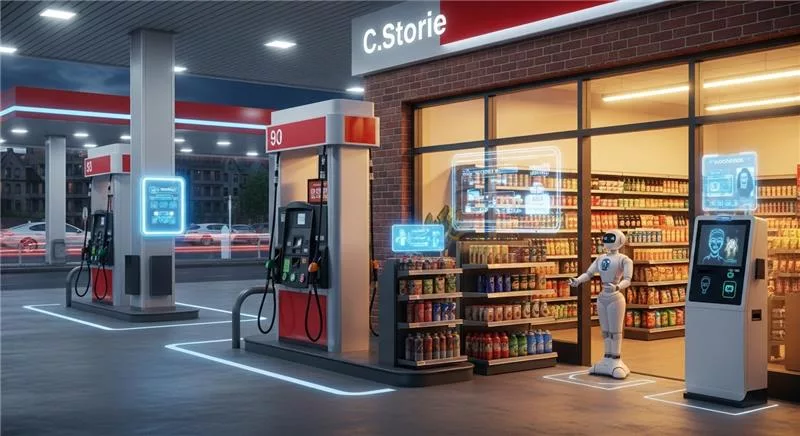Estimated reading time: 5 minutes
In past articles, we looked at what AI is actually doing in convenience stores and gas stations right now. But we’re not alone in this tech journey. Big retailers – the Walmarts, Targets, and Home Depots of the world – have been investing heavily in AI for years. What can we, as C-store and fuel operators, learn from their experiences? And maybe more importantly, what mistakes should we try to avoid?
The scale is different, obviously, but many of the challenges are the same: managing inventory, optimizing staffing, preventing loss, and understanding customers. Looking at how the big players use AI can give us ideas but also highlight potential pitfalls.
This article series is dedicated to a deep and comprehensive exploration of the role of artificial intelligence in business. We will examine how companies of various sizes and across different industries are leveraging machine learning, generative AI, and neural networks to drive growth, improve efficiency, and gain a competitive edge.
Each article will focus on a specific area of application — whether it’s AI in retail, logistics, or human resource management. We will pay special attention to practical case studies as well as the ethical, legal, and strategic aspects of AI implementation.
This is not just a review of trendy technologies — it’s a conversation about the transformation of business logic in an era where algorithms can make decisions as well as humans.
- Fueling the Future: How Petrosoft’s Tech Vision Drives C-Store and Gas Station Innovation
- Beyond the Hype: The “Pain” and “Gain” of AI Implementation for C-Store and Gas Station Owners
- Unlocking Hidden Margins: The C-Store Inventory Management Secrets Top Operators Swear By
- Your C-Store Is Wasting Hours – Could AI Be the Secret Weapon?
Lessons from the Big Boxes
Major retailers are using AI across their operations in ways that have parallels to our industry:
- Sophisticated Inventory & Planograms: Forget simple reordering. Big retailers use AI to analyze vast amounts of data to optimize store layouts (planograms), predict demand for thousands of SKUs down to the individual store level, and automate restocking processes. They know exactly where that specific brand of soda sells best and ensure it’s there. While we might not need that level of granularity, the principle of using data to place products effectively and predict demand is directly applicable.
- Workforce Optimization: Scheduling staff in a large store or across a chain is complex. AI tools help big retailers predict customer traffic patterns and optimize schedules to ensure enough coverage during peak times without overspending on labor during lulls. For multi-site C-store operators, similar tools could help allocate staff more efficiently across locations.
- Visual AI for Operations & LP: This is a growing area. Think beyond basic security cameras. Retailers are using AI-powered image recognition for:
- Shelf Scanning: Systems (sometimes using cameras, sometimes robots) monitor shelves to check for out-of-stocks, ensure price tags are correct, and verify planogram compliance. Think about companies like Retail Aware or the tech behind smart coolers like Cooler Screens. This is more advanced than simple barcode scanning.
- Loss Prevention: AI analyzes video feeds to detect suspicious behavior associated with shoplifting or Organized Retail Crime (ORC). Companies like Sensormatic offer sophisticated analytics platforms (like their Shrink Analyzer that uses RFID/item data) that go beyond just recording video, trying to identify patterns of loss.
Warnings and Watchouts
Just because big retail is doing it doesn’t mean it’s always right or easy, especially for smaller operators:
- Costly Mistakes & Complexity: Big retailers have deep pockets. They can afford to experiment with expensive AI projects that might not pan out. Smaller operators need to be much more focused on clear ROI. Implementing complex AI often requires significant investment not just in the software, but also in data infrastructure, integration, and training. Don’t chase the shiniest new AI toy without a clear business case. I remember us at Market24 getting pitched a very complex analytics system years ago – it promised the world, but the setup cost and data requirements were just too much for us at the time. We opted for a simpler, more integrated solution that actually worked for our scale.
- Privacy Concerns & Compliance: This is huge, especially with visual AI. Using facial recognition for loss prevention (like tech from companies sometimes associated with Clearview AI or FaceFirst) is running into major headwinds. Cities and states are banning or restricting its use due to privacy and bias concerns. Even seemingly benign AI that tracks customer movement can feel intrusive if not handled carefully. You must be aware of local regulations and customer sentiment. Focusing on analyzing behavior patterns rather than identifying individuals is generally a safer path.
- Data Quality is Paramount: AI algorithms are hungry for data, and they need good data. If your inventory records are messy, your sales data is inconsistent, or your POS doesn’t capture things accurately, the AI’s predictions and insights will be flawed. Big retailers invest heavily in data cleansing and management; smaller operators need to ensure their foundational data practices are solid before layering complex AI on top.
The Balanced Perspective for C-Stores
So how do we apply these lessons?
- Learn from, Don’t Just Copy: See how AI helps big players optimize inventory or understand customer flow, but adapt the principles to your scale. Maybe you don’t need shelf-scanning robots, but better use of your POS and back-office data (like from Retail360) for inventory insights is achievable.
- Focus on Integrated Solutions: Avoid creating isolated AI tools. Look for solutions where AI enhances existing systems. For example, how does a loss prevention tool integrate with your POS data? Petrosoft’s LPA using camera feeds tied into transaction data is an example of this integrated approach, which is often more practical than standalone systems like some external LP platforms. Similarly, comparing Retail360’s shelf tag features to a third-party scanning app like Shelf Engine (now part of Crisp, focusing on perishables) involves looking at integration depth vs. specialized function.
- Prioritize Privacy & Practicality: Be very cautious with AI that could raise privacy flags. Focus on AI that improves efficiency (inventory, ordering, basic LP analytics) or customer experience (loyalty personalization) in ways that are clearly beneficial and non-intrusive.
Looking forward, we’ll dive deeper into specific operational areas like back-office tasks and invoicing, asking if AI is truly a time-saver or potentially a new kind of tech trap.
Stay Connected With Petrosoft
If you found this article helpful, don’t keep it to yourself—like, follow, and share to help others in the convenience store and gas station industry discover smarter solutions.
Subscribe to our YouTube channel for in-depth product demos, industry insights, and real-world success stories that show Petrosoft technology in action.
Follow us on social media for daily updates, customer spotlights, and tips on streamlining operations with solutions like C-Store Office®, SmartPOS®, and Retail360.
Together, we can transform retail operations—one store at a time.

Michael is a one of the industry experts that contribute to Petrosoft blog. Read more of his c-store and gas station insights click here


